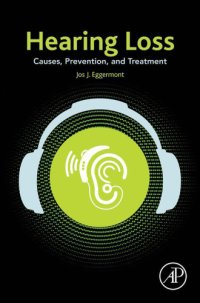
Ebook: Hearing loss: causes, prevention, and treatment
Author: Eggermont Jos J
- Tags: Deafness, Deafness--Prevention, Deafness--prevention & control, Hearing Aids, Hearing disorders, Hearing Disorders, Hearing Disorders--prevention & control, Hearing disorders--Treatment, Hearing Loss, Hearing--physiology, MEDICAL--Audiology & Speech Pathology, Electronic book, Electronic books, Deafness -- Prevention, Hearing disorders -- Treatment, MEDICAL -- Audiology & Speech Pathology, Hearing -- physiology, Deafness -- prevention & control, Hearing Disorders -- prevention & control
- Year: 2017
- Publisher: Elsevier Science & Technology
- City: London;U.K
- Language: English
- epub
Part I. The Basics -- 1. Hearing Basics. -- 1.1 Hearing Sensitivity in the Animal Kingdom -- 1.2 The Mammalian Middle Ear -- 1.3 The Mammalian Inner Ear -- 1.4 The Auditory Nerve -- 1.5 Ribbon Synapses -- 1.6 The Central Afferent System -- 1.7 The Efferent System -- 1.8 Sound Localization -- 1.9 Summary -- References -- 2. Brain Plasticity and Perceptual Learning -- 2.1 The External Environment -- 2.2 Learning Paradigms -- 2.3 Perceptual Learning -- 2.4 Auditory Training -- 2.5 AV Training -- 2.6 Music Training -- 2.7 Training by Playing Action Video Games -- 2.8 Summary -- References -- 3. Multisensory Processing -- 3.1 Multimodal Auditory Cortical Areas -- 3.2 AV Interaction in Humans -- 3.3 Auditory-Somatosensory Interaction -- 3.4 Summary -- References -- Part II. The Problem -- 4. Hearing Problems -- 4.1 The Various Consequences of Noise Exposure -- 4.2 Sound Localization Problems -- 4.3 The Cocktail Party, Where Identification and Localization Come Together -- 4.4 Other Consequences of Hearing Loss -- 4.5 Neurological Disorders With Hearing Problems -- 4.6 Hearing Disorders Without Hearing Sensitivity Loss -- 4.7 Nonauditory Effects of Hearing Loss -- 4.8 Summary -- References -- 5. Types of Hearing Loss -- 5.1 Site of Lesion Testing -- 5.2 Conductive Hearing Loss -- 5.3 Use of Tympanometry in Detecting Conductive Hearing Loss -- 5.4 Sensorineural Hearing Loss -- 5.5 Loudness Recruitment -- 5.6 Auditory Neuropathy -- 5.7 Vestibular Schwannoma -- 5.8 Ménière's Disease -- 5.9 Age-Related Hearing Impairment (Presbycusis) -- 5.10 Summary -- References -- Part III. The Causes -- 6. Causes of Acquired Hearing Loss -- 6.1 Occupational Noise Exposure in General -- 6.2 Recreational Noise and Music -- 6.3 Animal Research into Effects of Noise Exposure on the Brain -- 6.4 Ototoxicity -- 6.5 Long-Term Effects of Conductive Hearing Loss in Infancy -- 6.6 Vestibular Schwannoma -- 6.7 Ménière's Disease -- 6.8 Diabetes -- 6.9 Summary -- References -- 7. Epidemiology and Genetics of Hearing Loss and Tinnitus -- 7.1 Epidemiology of Sensorineural Hearing Loss -- 7.2 Epidemiology of Age-Related Hearing Loss -- 7.3 Epidemiology of Tinnitus -- 7.4 Epidemiology of Smoking and Alcohol Consumption -- 7.5 Epidemiology of Diabetes -- 7.6 Epidemiology of Otitis Media -- 7.7 Epidemiology of Auditory Neuropathy Spectrum Disorder -- 7.8 Genetics of Sensorineural Hearing Loss -- 7.9 Genetics of Otosclerosis -- 7.10 Genetics of Auditory Neuropathy -- 7.11 Gene Networks -- 7.12 Hereditary Versus Acquired Hearing Loss -- 7.13 Summary -- References -- 8. Early Diagnosis and Prevention of Hearing Loss -- 8.1 Normal Human Auditory Development -- 8.2 Effects of Early Hearing Loss on Speech Production -- 8.3 Early Detection -- 8.4 Noise Exposure During Adolescence and Young Adulthood -- 8.5 Physical Hearing Protection -- 8.6 Education -- 8.7 Drug Protection Against Noise-Induced Hearing Loss -- 8.8 Summary -- References -- Part IV. The Treatments -- 9. Hearing Aids -- 9.1 Effects of Hearing Loss -- 9.2 Acclimatization and Plasticity -- 9.3 Satisfaction and Quality of Life -- 9.4 Types of Hearing Aids -- 9.5 Processing -- 9.6 High-Frequency Hearing Loss, Loudness Recruitment, and Reduced SNR -- 9.7 Hearing Aids and Music Perception -- 9.8 Hearing Aids and Tinnitus -- 9.9 Summary -- References -- 10. Implantable Hearing Aids -- 10.1 Bone Conduction Mechanisms -- 10.2 Bone-Anchored Hearing Aids -- 10.3 Implantable Active Middle Ear Devices -- 10.4 Summary -- References -- 11. Cochlear Implants -- 11.1 Basics of Cochlear Implants -- 11.2 A Little History -- 11.3 Sound Processing Strategies -- 11.4 Temporal Processing With a Cochlear Implant -- 11.5 Effects of Age on Implantation -- 11.6 Cochlear Implants and Music Perception -- 11.7 One-Sided or Bilateral Implantation? -- 11.8 Cochlear Implantation and Tinnitus -- 11.9 Modeling Studies -- 11.10 Summary -- References -- Part V. The Future -- 12. Auditory Brainstem and Midbrain Implants -- 12.1 Auditory Brainstem Implants -- 12.2 Auditory Midbrain Implants -- 12.3 Summary -- References -- 13. Repairing and Building New Ears -- 13.1 Gene Therapy for Hereditary Hearing Loss -- 13.2 Regenerating Hair Cells -- 13.3 Birds Can Do It -- 13.4 Trials in Mammals -- 13.5 Outlook -- References -- Appendix A: Electrocochleography From the Promontory and via a Cochlear Implant.;"Hearing Loss: Causes, Prevention, and Treatment covers hearing loss, causes and prevention, treatments, and future directions in the field, also looking at the cognitive problems that can develop. To avoid the "silent epidemic" of hearing loss, it is necessary to promote early screening, use hearing protection, and change public attitudes toward noise. Successful treatments of hearing loss deal with restoring hearing sensitivity via hearing aids, including cochlear, brainstem, or midbrain implants. Both the technical aspects and effects on the quality of life of these devices are discussed. The integration of all aspects of hearing, hearing loss, prevention, and treatment make this a perfect one-volume course in audiology at the graduate student level. However, it is also a great reference for established audiologists, ear surgeons, neurologists, and pediatric and geriatric professionals"--Publisher's description.
Download the book Hearing loss: causes, prevention, and treatment for free or read online
Continue reading on any device:

Last viewed books
Related books
{related-news}
Comments (0)